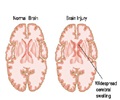Adults who were exposed to lead as children incur permanent brain injury, concludes a new study.
A new study has concluded that lead exposure in children causes permanent injury to the brain.
The research, which used functional magnetic resonance imaging (fMRI) to evaluate brain function, was presented at the annual meeting of the Radiological Society of North America (RSNA)."What we have found is that no region of the brain is spared from lead exposure," said the study's lead author, Kim Cecil, Ph.D., imaging scientist at Cincinnati Children's Hospital Medical Center and professor of radiology, pediatrics and neuroscience at the University of Cincinnati College of Medicine.
"Distinct areas of the brain are affected differently," the expert added.
Lead, a common and potent poison found in water, soil and lead-based paint, is especially toxic to children's rapidly developing nervous systems.
"Lead exposure has been associated with diminished IQ, poor academic performance, inability to focus and increased risk of criminal behavior," Cecil said.
Cecil's study involved 33 adults who were enrolled as infants in the Cincinnati Lead Study. The mean age of the study participants, which included 14 women and 19 men, was 21 years. The participants' mean blood lead levels ranged from 5 to 37 micrograms per deciliter with a mean of 14. Participant histories showed IQ deficiencies, juvenile delinquency and a number of criminal arrests.
Advertisement
The imaging revealed that in order to complete a task that required inhibition, those with increased blood lead levels required activation from additional regions within the frontal and parietal lobes of the brain.
Advertisement
Imaging performed during a second task designed to test attention revealed an association between higher lead levels and decreased activation in the parietal region and other areas of the brain.
According to Cecil, the brain's white matter, which organizes and matures at an early age, adapts to lead exposure, while the frontal lobe, which is the last part of the brain to develop, incurs multiple insults from lead exposure as it matures.
"Many people think that once lead blood levels decrease, the effects should be reversible, but, in fact, lead exposure has harmful and lasting effects," she said.
Source-ANI
TAN














